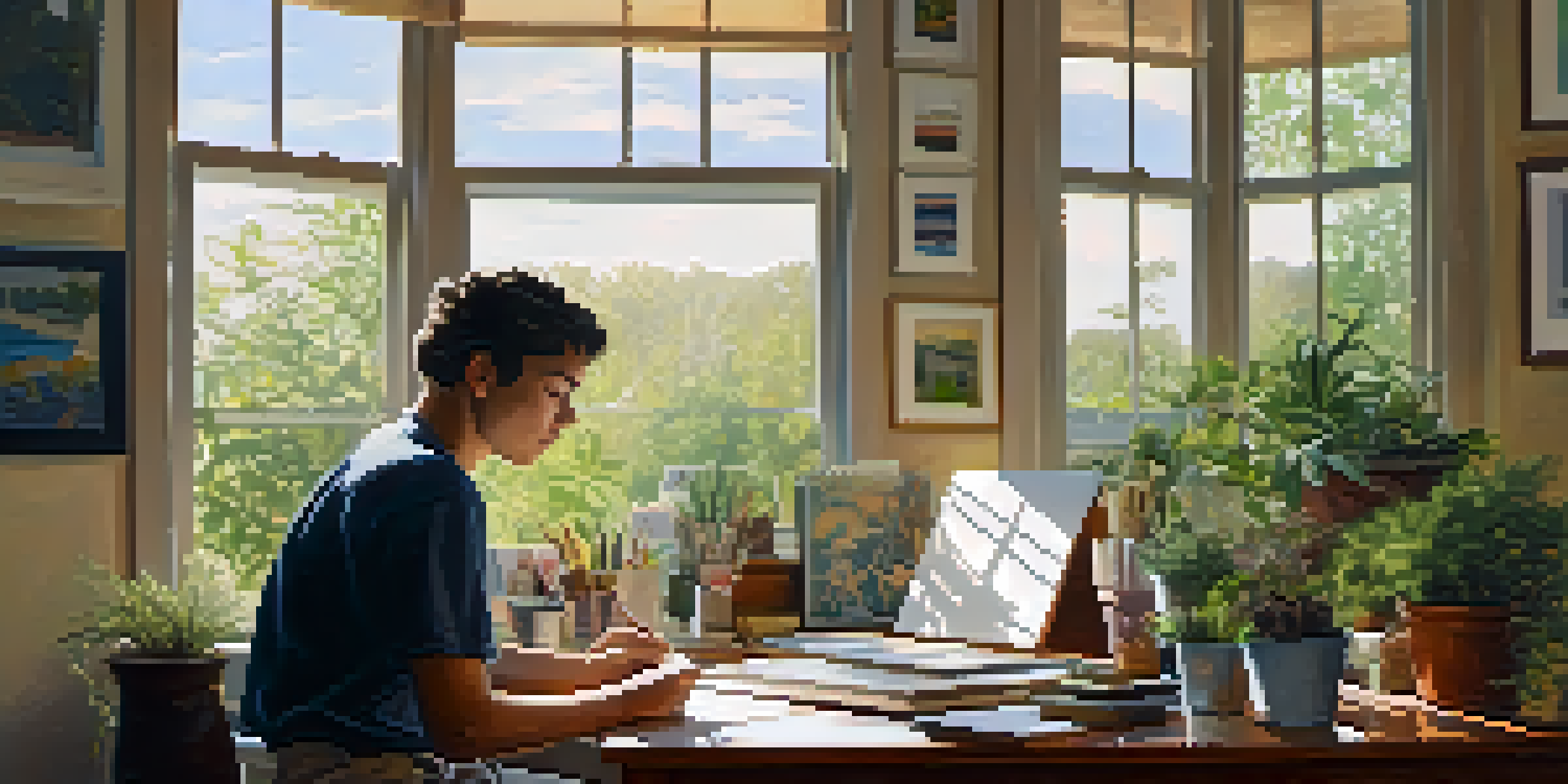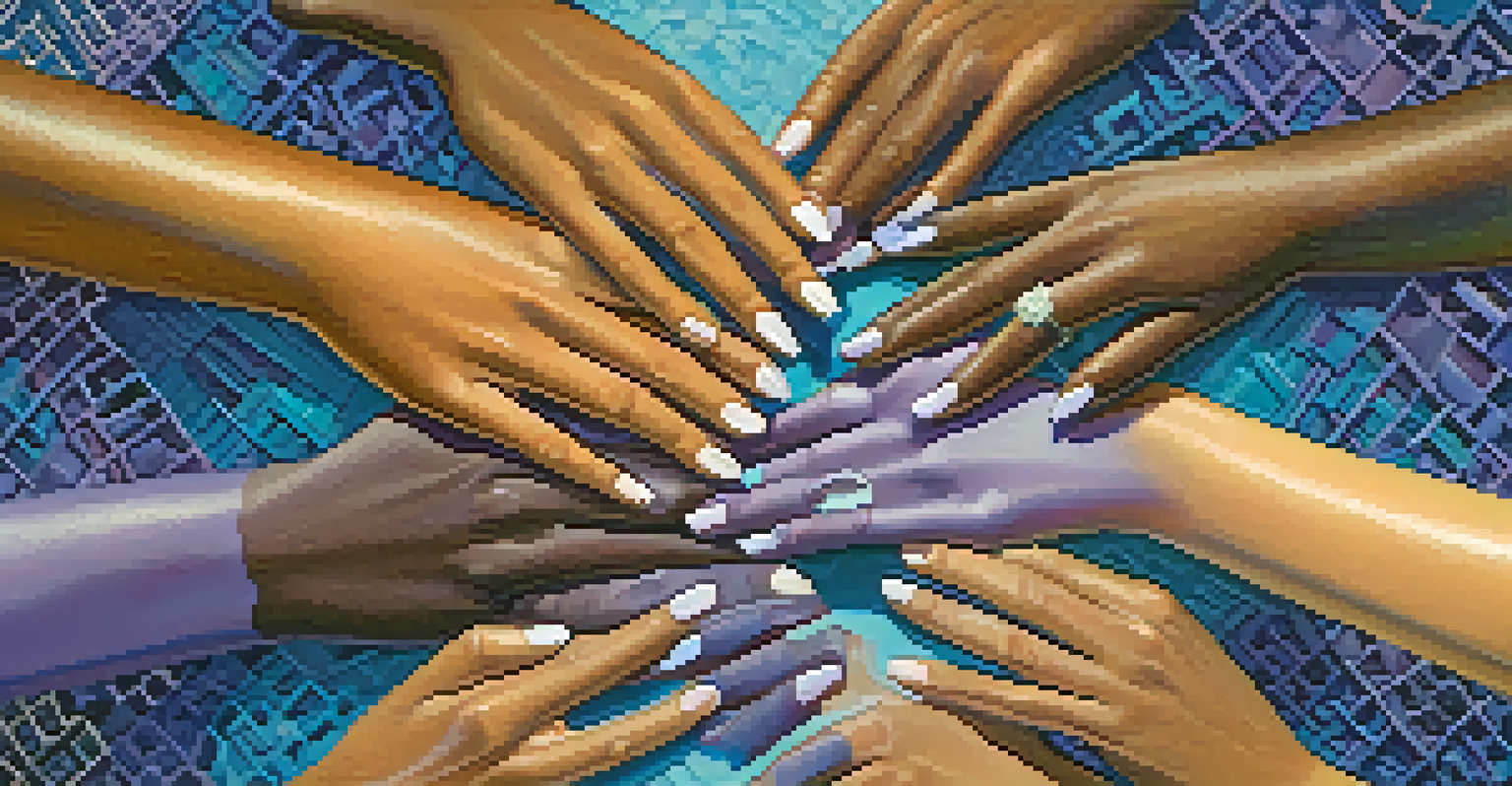Visual Representation of LGBTQ+ Identities in Modern Art

Understanding the Importance of Representation in Art
Representation in art is crucial because it reflects society's values and beliefs. When LGBTQ+ identities are visible in art, it affirms the existence and experiences of these communities. This visibility can help challenge stereotypes and promote understanding, fostering a more inclusive society.
Art is not freedom from discipline, but disciplined freedom.
Historically, many artists from the LGBTQ+ community faced marginalization, leading to a lack of representation. However, modern art movements have begun to embrace and celebrate these identities. By showcasing LGBTQ+ narratives, artists provide a platform for voices that were once silenced, creating a richer cultural tapestry.
Art can be a powerful tool for social change. When LGBTQ+ identities are represented authentically, it encourages dialogue and empathy. This shift not only benefits the community but also enriches the artistic landscape for everyone.
Key Themes in LGBTQ+ Art Representation
Modern art often explores themes of identity, love, and resistance, which resonate deeply within LGBTQ+ narratives. Artists may use their work to address issues such as gender fluidity, sexual orientation, and societal norms. By doing so, they invite viewers to reflect on their own understanding of these concepts.

Another prevalent theme is the intersectionality of identities, where artists highlight the diverse experiences within the LGBTQ+ spectrum. This aspect emphasizes that no single narrative can define what it means to be part of this community. For instance, an artwork might explore the experiences of a Black transgender person, shedding light on unique challenges faced.
Art Reflects LGBTQ+ Community Values
Representation in art is vital as it affirms LGBTQ+ identities and challenges societal stereotypes.
Moreover, many modern artworks tackle the historical struggles of LGBTQ+ individuals, such as the fight against discrimination and the AIDS crisis. By remembering these events, artists ensure that their stories are not forgotten, fostering a sense of solidarity and resilience.
Influential LGBTQ+ Artists Shaping Modern Art
Several contemporary artists have made significant contributions to the visual representation of LGBTQ+ identities. For example, Keith Haring's vibrant murals often celebrated love and acceptance, while also addressing the AIDS epidemic. His work continues to inspire new generations to advocate for LGBTQ+ rights.
The role of the artist is to ask questions, not to answer them.
Another notable figure is Frida Kahlo, whose art deeply reflects her bisexuality and the struggles of her identity. Kahlo's self-portraits invite viewers into her world, revealing the complexities of her experiences. Her work remains a powerful symbol of self-acceptance and resilience.
Additionally, artists like David Hockney and Yayoi Kusama have used their platforms to explore themes of love and identity. Their contributions emphasize that personal narratives can resonate on a universal level, promoting understanding and connection across diverse audiences.
The Role of Galleries and Exhibitions in LGBTQ+ Art
Galleries and exhibitions play a pivotal role in showcasing LGBTQ+ art and fostering community engagement. By dedicating space to LGBTQ+ artists, these institutions help create a sense of belonging and visibility. This support is essential for cultivating new talent and encouraging diverse narratives.
Special exhibitions often focus on LGBTQ+ themes, providing a platform for dialogue and education. For example, events like Pride Month exhibitions can highlight the contributions of LGBTQ+ artists while addressing the ongoing struggles for equality. These initiatives encourage visitors to learn more about LGBTQ+ history and culture.
Digital Media Empowers LGBTQ+ Artists
Social media has transformed how LGBTQ+ artists share their work, allowing for greater visibility and connection with audiences.
Moreover, online galleries and virtual exhibitions have expanded access to LGBTQ+ art, allowing a global audience to engage with these important works. This accessibility ensures that the stories and experiences represented in the art can reach and resonate with more people than ever before.
The Impact of Digital Media on LGBTQ+ Art
In today's digital age, social media platforms have transformed how LGBTQ+ artists share their work. Artists can now reach wider audiences, bypassing traditional gatekeepers. This democratization of art allows for a more diverse range of voices to emerge and be celebrated.
Platforms like Instagram and TikTok enable artists to connect directly with their audience, fostering a sense of community. Many LGBTQ+ artists use these spaces to share their creative processes and personal stories, inviting followers into their world. This interaction builds a supportive network that can amplify their messages.
Furthermore, digital art forms, such as GIFs and animations, have become popular mediums for expressing LGBTQ+ identities. These formats allow for innovative storytelling and emotional expression, enabling artists to explore themes in dynamic and engaging ways.
Challenges Facing LGBTQ+ Artists Today
Despite the progress made in representing LGBTQ+ identities in modern art, challenges still exist. Many LGBTQ+ artists struggle with visibility and funding, often facing barriers when seeking support for their work. This lack of resources can hinder their ability to create and share their art.
Additionally, some artists encounter discrimination or bias within the art community. This prejudice can manifest in various forms, from exclusion in exhibitions to negative criticism of their work. Such challenges can discourage artists from fully expressing their identities and experiences.
Challenges Persist for LGBTQ+ Artists
Despite advancements, LGBTQ+ artists still face barriers like funding issues and discrimination within the art community.
Moreover, the commercialization of art can sometimes overshadow the authentic narratives of LGBTQ+ artists. When art is commodified, the deeper messages can be diluted. It’s essential for both artists and audiences to prioritize genuine representation and support those who authentically express their identities.
Future Directions for LGBTQ+ Art Representation
Looking ahead, the future of LGBTQ+ representation in art appears promising. As society continues to evolve, so too will the narratives and themes explored by artists. The ongoing conversations around inclusion and diversity will likely inspire even more innovative expressions of LGBTQ+ identities.
Emerging artists are already pushing boundaries by experimenting with new forms and mediums. This experimentation can lead to fresh perspectives on identity and culture, enriching the overall art landscape. By embracing change, the art world can continue to reflect the complexities of modern identities.

Moreover, collaboration between artists, institutions, and communities will be crucial in fostering a supportive environment. By working together, they can ensure that LGBTQ+ narratives remain visible and celebrated, paving the way for future generations of artists and advocates.